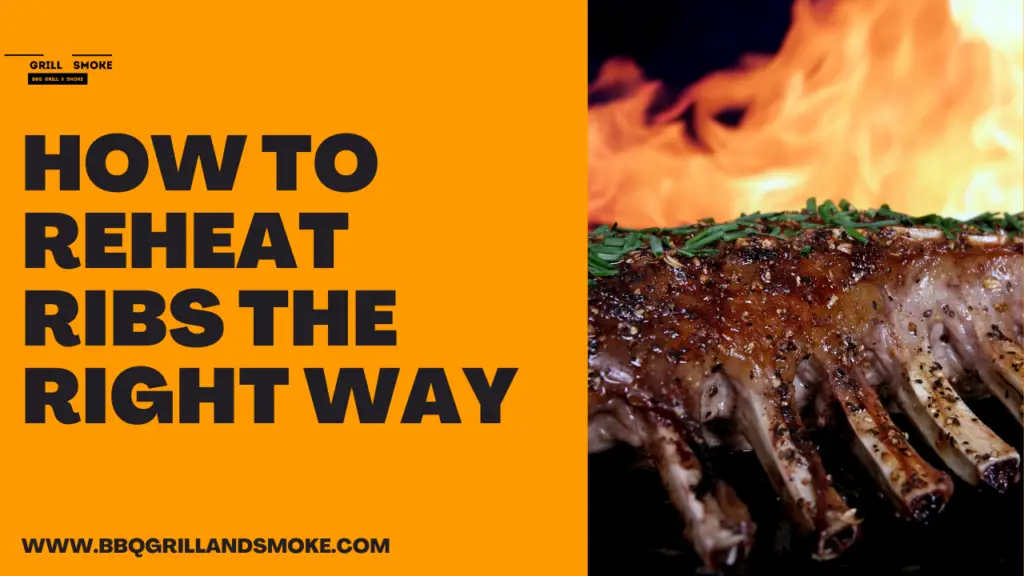The best way to preserve your time and fuel is to cook several racks of ribs at one which will, in turn, get you to store and reheat them later. But, I’m sure your question now is how to reheat ribs the right way as storing them might not be an issue for you.

You will be learning from this guide, how you can reheat your ribs which also lose their high quality as it was when they freshly got off the smoker.
You will also get to learn the best ways you can store your ribs and also the best ways to keep them soft and mouth-watering even after reheating them.
And, even to save money, I strongly recommend you cook multiple racks of ribs and then store the leftovers to reheat them later.
Many people make the mistake of drying their ribs out when reheating them, this is one of the things I will help you avoid through the details about reheating ribs in this guide.
How to Reheat Ribs without Drying Them Out
Proper storage is what is quite essential for reheating ribs and not having them become a dried-out chewy mess.
So, make sure you have as much moisture as you can get if you are freezing or probably refrigerating the ribs.
Let’s quickly go over some important tips for rightly storing and reheating your ribs while still maintaining the best from your remaining rack.
- From around 40 degrees Fahrenheit to 140 degrees Fahrenheit are considered to be danger zones for meat and the longer your meat spends here, the faster the colonies of bacteria such as Salmonella, Staphylococcus, and E. coli begin to grow so, this is to say make sure you refrigerate your ribs without delay.
- Then cut your ribs into single-serving-sized parts and proceed to wrap them in a double layer of foil, get a waterproof plastic bag and seal them in.
- Get a cooler filled with ice and put them in it and make sure you do not leave your meat unrefrigerated for too long, 2 hours max.
- When storing your ribs, you can minimize the loss of moisture by keeping them in a sealed container or a vacuum-sealed bag which is most preferable.
- And, to kill off any surviving bacteria get the internal temperature of your ribs to reach at least 145 degrees Fahrenheit.
- You should know that you will lose some amount of moisture to cooking, refrigeration, freezing, and reheating your ribs.
- So, you need to add some moisture back into your ribs when reheating them and you can do that by spraying off broth or coke which are best suitable for beef ribs, and pork ribs, I will recommend apple juice or cider vinegar.
- High direct heat should be best avoided when reheating your ribs so, the best way to reheat them is to low and slow cook them.
How to Reheat Ribs in Oven
- Warm-up your oven to 400 degrees Fahrenheit and get a large sheet of foil and place your ribs on it.
- Then fold the sides of the foil up but, do not seal them yet. Afterward, get 1/8 cup of water, BBQ sauce, or broth and add it to the foil.
- You can then proceed to seal the foil totally and get a glass casserole dish or nay pan with 2 inches sides to place the foil-wrapped ribs in.
- Put the pan to 400 degrees Fahrenheit, in 15 minutes, check the ribs using a meat thermometer.
- Check the ribs in another 5 minutes if their internal temperature is yet to reach 145 degrees Fahrenheit.
- And, after the internal temperature of the ribs has gotten to 145 degrees Fahrenheit, you can then bring it out of the oven and leave it in the open air for 5 minutes then proceed to serve it.
- Remember that you should only reheat your beef rib meat till its internal temperature reaches 145 degrees Fahrenheit.
Use The Sous Vide Method to Reheat Ribs
Sous vide in English means under vacuum. This method is about cooking food that has been locked up in a plastic bag by making use of a hot water bath.
This method will be best suitable for you if you have already adopted the idea of using a vacuum sealer for the storage of your food.
All that is then required from you is just for you to get your stored ribs from your freezer or fridge and then put them into the Sous vide directly.
You can make use of a large pot over the stove-top or you can decide to make use of the specialized sous vide cookers.
- Get the water in the sous vide machine or a portable stove-pot pot to 165 degrees Fahrenheit.
- Then proceed to get your leftover ribs which are now inside the vacuum bags and place them into the machine or pot.
- And, according to the inch of the thickness of the contents, you are to leave the bags inside the hot water and let them sit there for 45 minutes.
- It should go for another extra 30 minutes if the stored ribs you are cooking are frozen.
The bags are airtight and the sous vide make use of indirect heat to cook the ribs so, adding extra moisture is not that essential or compulsory with this method.
I strongly recommend you get a vacuum sealer as it is quite useful in the kitchen to store and reheat ribs and BBQ leftovers
Should You Reheat Ribs in The Microwave?
Microwave can be used because it is fast and simple which is also why it has been adopted by so many people.
But, you should know that using a microwave to reheat your ribs will not give you the best results you desire.
This is because the microwave is quite known for its high tendency of drying out food and also for not heating food harmoniously.
Although you can adopt this method if the time is against you and you need to reheat your ribs.
Conclusion on How to Reheat Ribs the Right Way
There are still some other ways to reheat ribs and they include using an air fryer, a steamer, and a microwave.
And, there are some preferred ways of storing ribs and they include using your freezer to store your ribs and also storing ribs in your refrigerator.
I can be quite certain now that you fully know and understand how to reheat ribs in the right way which will bring to the wrap-up of this guide.





